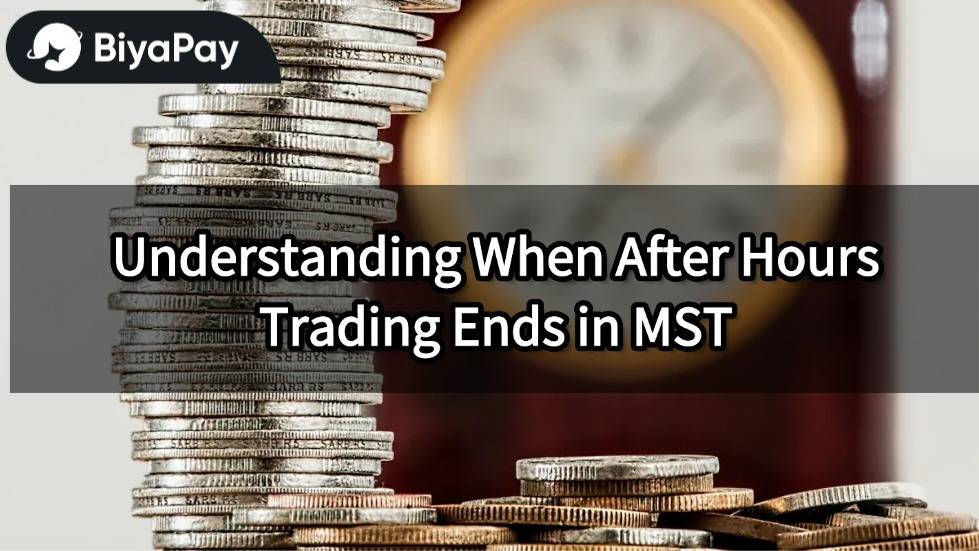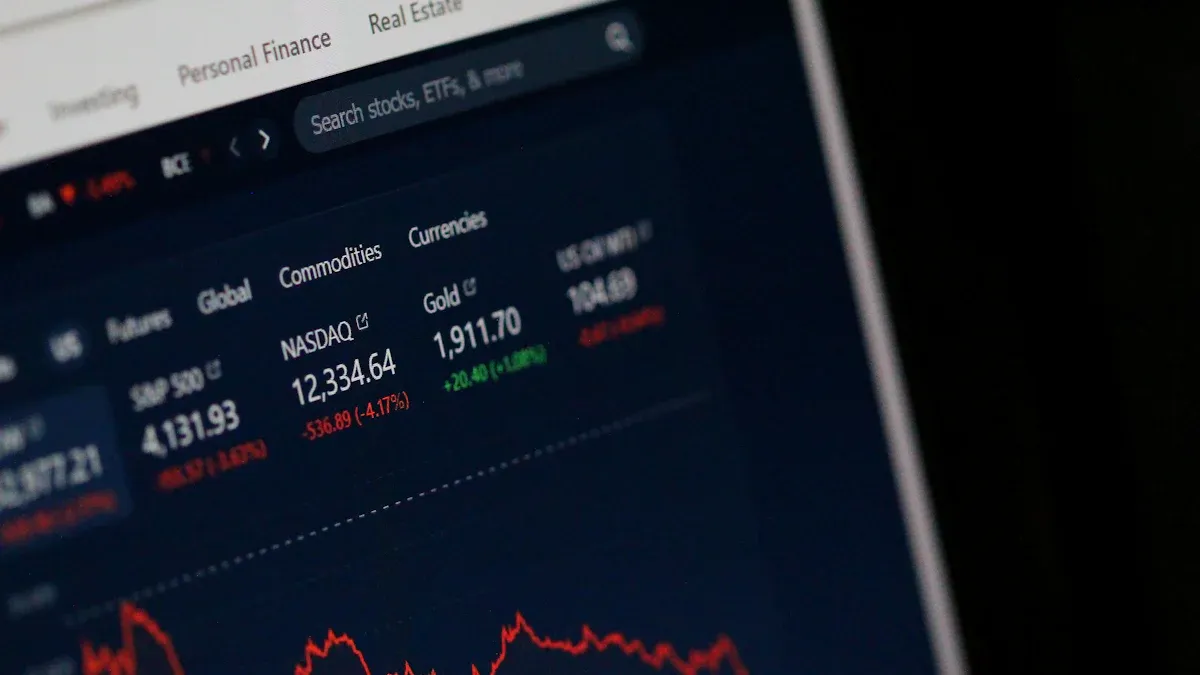- EasyCard
- Trade
- Help
- Announcement
- Academy
- SWIFT Code
- Iban Number
- Referral
- Customer Service
- Blog
- Creator
Understanding When After Hours Trading Ends in MST

Image Source: pexels
After-hours trading ends at 6:00 p.m. MST. This timing comes from the standard U.S. after-hours trading session, which allows orders between 4:00 p.m. and 8:00 p.m. Eastern Time. Orders not filled by 8:00 p.m. ET are canceled, so the session closes at that exact time. FINRA rules confirm that trades made after 4:00 p.m. and up to 8:00 p.m. ET fall under after-hours trading. Some brokers may set different cut-off times, so investors should always check their platform. Knowing when does after hours trading end mst helps investors manage trades and avoid missing opportunities.
Key Points:
- After-hours trading ends at 6:00 p.m. MST.
- Some brokers may have different cut-off times.
- Always confirm with your broker to know when does after hours trading end mst for your account.
Key Takeaways
- After-hours trading ends at 6:00 p.m. MST, matching the 8:00 p.m. Eastern Time close.
- Broker cut-off times can vary, so always check your broker’s rules to avoid missed trades.
- Daylight saving time can change local trading times, so confirm your local clock and broker’s schedule.
- After-hours trading uses limit orders and has lower volume, which can cause bigger price swings.
- Set reminders for the 6:00 p.m. MST deadline to plan trades and react quickly to market news.
What Is After-Hours Trading?
Definition
After-hours trading refers to the buying and selling of stocks outside the regular market hours. The main U.S. stock exchanges open from 9:30 a.m. to 4:00 p.m. Eastern Time. After-hours trading takes place after the market closes, usually from 4:00 p.m. to 8:00 p.m. Eastern Time. This period allows investors to react to news, earnings reports, or global events that happen after the regular session ends.
- After-hours trading uses electronic communication networks (ECNs) to match buy and sell orders.
- Both individual and institutional investors can participate.
- The market often sees less activity during these hours, which can lead to higher price swings.
- Orders placed during after-hours trading are usually limit orders, meaning investors set the price at which they want to buy or sell.
- Orders do not carry over to the next day’s session.
Note: After-hours trading gives investors more flexibility, but it also comes with risks like lower liquidity and wider price gaps.
How It Works
After-hours trading operates through ECNs and sometimes through special sessions on traditional stock exchanges. These networks allow investors to place orders even when the main market is closed. Most activity happens right after the closing bell, as investors respond to late-breaking news.
- ECNs provide a platform for both retail and institutional investors.
- The volume of trades is lower than during regular hours, so prices can change quickly.
- Only limit orders are accepted, which helps protect investors from unexpected price changes.
- Regulatory bodies such as FINRA and the SEC set rules to keep after-hours trading fair and transparent.
- Clearance and settlement for trades follow the same process as during regular hours, but all trades must be completed within the session.
Investors should also know about premarket trading, which happens before the regular session starts. Both premarket trading and after-hours trading fall under the broader term “extended-hours trading.” Extended hours give investors more chances to trade, but they should always consider the risks, such as lower trading volume and the chance that their orders may not get filled.
When Does After Hours Trading End MST

Image Source: pexels
Standard End Time
After-hours trading gives investors more time to buy and sell stocks after the regular market closes. In the United States, the main after-hours trading session starts at 4:00 p.m. Eastern Time and ends at 8:00 p.m. Eastern Time. For people living in the Mountain Standard Time zone, this means the session ends at 6:00 p.m. MST. Many investors ask, “when does after hours trading end mst?” The answer is simple: the session closes at 6:00 p.m. MST, which matches the 8:00 p.m. ET close.
Knowing the exact end time helps investors plan their trades. If someone places an order after 6:00 p.m. MST, the system will not process it until the next trading day. This rule applies to most major U.S. stock exchanges. Investors who want to trade during after-hours trading must finish their orders before the session ends. Missing the cut-off can mean missing out on important price changes or news events.
Tip: Always check the clock and set reminders for the 6:00 p.m. MST deadline. This habit helps investors avoid last-minute mistakes.
Broker Variations
Not every broker follows the same schedule for after-hours trading. Some brokers may end their after-hours session earlier than 8:00 p.m. ET, which means the session could close before 6:00 p.m. MST. For example, a broker might stop accepting after-hours trades at 7:00 p.m. ET, which is 5:00 p.m. MST. This difference can affect when does after hours trading end mst for each investor.
Brokers set their own rules based on their systems and risk controls. Some platforms may also limit which stocks can be traded during after-hours trading. Investors should always check with their broker to confirm the exact end time for after-hours trading. This step is important because missing the correct time can lead to missed opportunities or unfilled orders.
- Some brokers post their after-hours trading schedule on their website.
- Customer service can answer questions about session times.
- Mobile trading apps often show a countdown or alert when the session is about to end.
Note: Investors should never assume all brokers follow the same schedule. Checking the platform’s rules helps avoid confusion about when does after hours trading end mst.
Planning trades around the correct end time is important for success. Investors who know the exact schedule can react quickly to news and market changes. They can also avoid the risk of placing orders that will not get filled. Understanding the details of after-hours trading helps investors make better decisions and manage their investments with confidence.
Time Zone Comparison

Image Source: unsplash
MST vs. EST and PST
Investors in different parts of the United States often need to know how after-hours trading times compare across time zones. The three main time zones for U.S. stock trading are Eastern Standard Time (EST), Mountain Standard Time (MST), and Pacific Standard Time (PST). Each time zone has its own offset from Coordinated Universal Time (UTC). This offset helps people convert trading times easily.
Here is a simple table that shows the UTC offsets for each time zone, both during standard time and daylight saving time:
| Time Zone | UTC Offset (Standard Time) | UTC Offset (Daylight Saving Time) |
|---|---|---|
| MST | UTC -7 hours | UTC -6 hours (MDT) |
| EST | UTC -5 hours | UTC -4 hours (EDT) |
| PST | UTC -8 hours | UTC -7 hours (PDT) |
For example, when after-hours trading ends at 8:00 p.m. EST, it is 6:00 p.m. MST and 5:00 p.m. PST. This table helps investors see the differences at a glance. Knowing these times helps investors avoid confusion and plan their trades better.
Daylight Saving Time
Daylight saving time can change the time difference between zones. In the spring, clocks move forward by one hour. In the fall, clocks move back by one hour. Not all states or regions follow daylight saving time, so the time difference may change during the year.
During daylight saving time, MST becomes Mountain Daylight Time (MDT), EST becomes Eastern Daylight Time (EDT), and PST becomes Pacific Daylight Time (PDT). The end time for after-hours trading stays the same in Eastern Time, but the local time in other zones may shift. Investors should check if their area observes daylight saving time. This step helps them avoid missing the end of the trading session.
Tip: Always check your local clock and your broker’s platform during daylight saving time changes. This habit helps you keep track of after-hours trading deadlines.
Factors Affecting After-Hours Trading
Broker Policies
Broker policies play a major role in shaping the experience of investors during extended trading sessions. Each broker sets its own rules for when trading ends, which can range from 5:00 p.m. to 8:00 p.m. Eastern Time. These differences reflect the unique capabilities and needs of each platform. Brokers must also manage risks and keep their systems secure during these hours.
- Broker-dealers and clearinghouses often adjust their workforce schedules to support longer trading hours.
- Many brokers upgrade their systems and use advanced tools, such as AI and algorithmic trading, to handle increased volatility and lower liquidity.
- Retail investors may face challenges, like wider price spreads and fewer buyers or sellers, which can affect trade execution.
- Brokers usually allow only limit orders during extended hours and may require investors to opt in before participating.
- Capital markets organizations often conduct stress tests and system upgrades to handle higher trading volumes and operational demands.
These policies help protect both the broker and the investor. They also ensure that trading remains fair and efficient, even outside regular market hours.
Market Holidays
Market holidays can change the normal schedule for trading. Historical data shows that trading volumes often drop before holidays. Many investors choose to reduce their activity ahead of long weekends. Stock prices sometimes rise before holidays because of positive market sentiment. Traders may sell more volatile stocks to lower their risk.
- The week before Labor Day usually sees lighter trading and less market activity.
- On the first trading day after Labor Day, trading volumes and volatility often increase as investors react to news from the holiday period.
- Extended hours trading may be limited or unavailable on holidays like Labor Day, which affects when investors can place trades.
- The bond market also closes on major holidays, which reduces overall market liquidity.
Investors should always check the holiday schedule for their broker and the stock exchange. This helps them plan their trades and avoid surprises.
After-hours trading ends at 6:00 p.m. MST. Investors should always check with their broker for any differences in session times. Time zones and daylight saving changes can affect when trading sessions close. Understanding these details helps investors avoid mistakes. Careful planning allows them to react quickly to market news and manage trades with confidence.
Tip: Set reminders for trading deadlines to stay on track and make informed decisions.
FAQ
What is the latest time to place an after-hours trade in MST?
Investors can place after-hours trades until 6:00 p.m. MST. Orders submitted after this time will not process until the next trading session. Always check the broker’s platform for any changes to this schedule.
Do all brokers allow after-hours trading until 6:00 p.m. MST?
Not all brokers follow the same schedule. Some may close after-hours trading earlier. Investors should review their broker’s rules or contact customer service to confirm the exact end time for after-hours trading.
Does daylight saving time affect after-hours trading in MST?
Daylight saving time can change the time difference between MST and Eastern Time. The after-hours session always ends at 8:00 p.m. Eastern Time. Investors should check if their area observes daylight saving time to avoid confusion.
Can investors trade all stocks during after-hours sessions?
Most brokers limit after-hours trading to certain stocks. Usually, only stocks listed on major U.S. exchanges are available. Investors should check which stocks their broker supports during extended hours.
Are there extra fees for after-hours trading?
Some brokers charge additional fees for after-hours trades. These fees can vary by platform. Investors should review the broker’s fee schedule before placing trades outside regular market hours.
Navigating after-hours trading, which ends at 6:00 p.m. MST (8:00 p.m. ET), requires precise timing to capitalize on market news while managing risks from lower liquidity and volatile price swings. For investors seeking to diversify across global markets, high cross-border fees and the complexity of opening overseas accounts can complicate trading during these extended hours, especially when coordinating with markets like Hong Kong.BiyaPay.simplifies this by enabling you to invest in both U.S. and Hong Kong stock markets directly on its platform without needing an overseas account. With real-time, fee-free conversion of over 200 digital currencies, including USDT, into 30+ fiat currencies like USD and HKD, and cross-border remittance fees as low as 0.5%, BiyaPay offers cost-efficient access to global markets. A 1-minute BiyaPay account registration provides rapid, secure entry, empowering you to execute timely trades across time zones and optimize your strategy in 2025’s dynamic market environment.
Maximize your after-hours trading in 2025! Join BiyaPay.
*This article is provided for general information purposes and does not constitute legal, tax or other professional advice from BiyaPay or its subsidiaries and its affiliates, and it is not intended as a substitute for obtaining advice from a financial advisor or any other professional.
We make no representations, warranties or warranties, express or implied, as to the accuracy, completeness or timeliness of the contents of this publication.




Contact Us
Company and Team
BiyaPay Products
Customer Services
is a broker-dealer registered with the U.S. Securities and Exchange Commission (SEC) (No.: 802-127417), member of the Financial Industry Regulatory Authority (FINRA) (CRD: 325027), member of the Securities Investor Protection Corporation (SIPC), and regulated by FINRA and SEC.
registered with the US Financial Crimes Enforcement Network (FinCEN), as a Money Services Business (MSB), registration number: 31000218637349, and regulated by FinCEN.
registered as Financial Service Provider (FSP number: FSP1007221) in New Zealand, and is a member of the Financial Dispute Resolution Scheme, a New Zealand independent dispute resolution service provider.



















